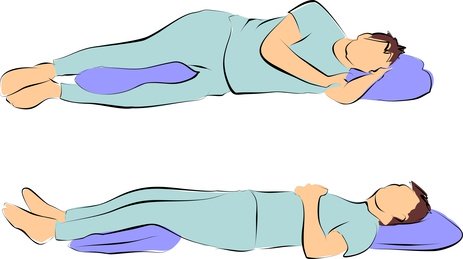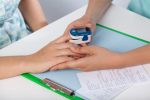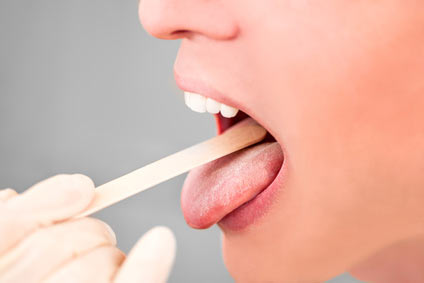Positional Therapy for Sleep Apnea
Side Sleeping to Treat Positional Sleep Apnea

Discover if positional therapy can be an alternative to CPAP in your fight with sleep apnea breathing disorder.
Millions of people in the world can't afford a sleep study, a CPAP machine and a mask, or even a doctor to let them know they suffer from apnea syndrome.
This article about positional sleep therapy for sleep apnea will answer to these questions:
- What is positional sleep apnea?
- How effective is positional sleep therapy in treating sleep apnea?
- What is best between positional therapy and CPAP in patients with positional obstructive sleep apnea.
- Is positional sleep therapy a good method to treat sleep apnea if you cannot afford the machine?
- How to make a homemade positional sleep apnea device?
- What are the best devices to help you sleep on the side?
- How to wear the bumper belt?
What is Positional Therapy?
We all heard the argument that if you elbow a snorer and they roll over, their snoring will stop.
In some cases, this actually works and after rolling over, the snorer and the person doing the elbowing both get a good and quiet night's rest.
Some devices were invented that help the snorer to sleep in a position that encourages less snoring. The Side Sleeping Backpack is a good example. The idea behind them is that if the snorer's body is in a certain position the airway through their throat will be more open and that allows a clearer passage of air.
The more air that gets through, the less likely the person is to snore or stop breathing during sleep.
What is Positional Therapy?
Positional sleep therapy consists in a method that keeps the patient with snoring or obstructive apnea in a side sleeping position, in order to prevent the airway to collapse. In order to understand why your airway may collapse, please read causes of sleep apnea.
How Effective is Positional Sleep Therapy?
Because snoring has similar causes with obstructive sleep apnoea (OSA), scientists decided to test the effectiveness of positional sleep therapy in OSA sufferers. In this clinical study published in 2012 scientists wanted to test the long term efficacy of this therapy in patients with positional OSA.
16 patients who couldn't tolerate CPAP were tested with the positional therapy device. They had to perform a test night study before wearing the device every night for 3 months. The patients were being monitored with an actigraphic recorder.
After 3 months, they were tested again with a follow-up night study. Scientists compared the results with the first night study, and their conclusion is: positional OSA can be effectively treated by a positional therapy.
What is Positional Sleep Apnoea?
Positional sleep therapy is better explained in Sleep Medicine: Essentials and Review book. You will learn that positional sleep apnea has been defined as obstructive sleep apnea in which the supine apnea hypopnea index (AHI) is at least twice that of sleep in a non-supine position (on the side).
Do You Have Positional Sleep Apnea?
According to the experts at the American College of Chest Physicians in the october 2005 issue of "Chest" magazine, as many as 60% of the patients with obstructive sleep apnea experience a lowering of symptoms when they slept on their side as opposed to their back.
They estimate that as many as 50% of the people that experience sleep apnea could be successfully treated by using positional therapy.
The explanation: In many patients with obstructive apnea, the upper airway is most vulnerable to collapse during supine sleep. Due to the effects of gravity, the tongue tends to be displaced closer to the posterior pharynx. There is, thus, greater reduction of the pharyngeal area in a supine than side sleeping position.
The solution: If your respiratory events occur exclusively or predominantly during a supine position and if your sleep study results demonstrates a normal apnea index in the lateral posture, then sleeping on the side or elevation of the head can be tried.
This video explains the relationships between sleep apnea and side sleeping:
Is Positional Sleep Therapy Effective for You?
You need to answer first to these questions:
- Have you received a copy of your sleep study report?
- Are you a patient with positional sleep apnea? Find the answer in your sleep report.
- Are there other issues (central apnea, RLS, PLMD, COPD)?
- What is your oxygen saturation level when sleeping on the side?
- How many positional apnea events you have compared to those sleeping on your back?
Without answering to these questions it's impossible to make suggestions about your sleep apnea treatment, including side sleeping therapy.
What if you can't afford a sleep study or a doctor? Use these links to learn more:
Some basic tips for discovering if you have OSA include:
What to Choose Between CPAP and Positional Therapy?
Without doubt, CPAP is the gold standard treatment for sleep apnea, and it's very effective as long as you can tolerate it. Many CPAP users have problems with these breathing machines, and my pages about CPAP problems and Mask problems can help them to improve their therapy.
But what if you:
- can't tolerate CPAP whatever you do,
- don't have enough money or insurance to pay the machine,
- love to travel often without carrying extra weight,
- want to try alternative options.
A sleep study confirmed that positional treatment and CPAP have similar efficacy in the treatment of patients with positional OSA. Find a more recent study here.
So there is no doubt that positional therapy can be your option. However, you have to know that you have positional sleep apnea. To find out, a sleep study will be excellent in this case.
Note: If you have central apnea, positional sleep therapy is not going to help!
See a doctor immediately if you suspect sleep apnea
Sleep apnea is potentially life-threatening. Counting on alternative therapies without receiving professional confirmation of their efficacy is like playing with your life.
If you do choose positional sleep therapy:
- bring your positional device with you in a sleep laboratory when you perform the sleep study.
- if you have a CPAP, use it while trying the alternative. This way you can check the full sleep report in the morning.
- Use other devices to check the quality of your sleep, like a portable pulse oximeter or sleep monitor.
Methods to Help You Sleep on Your Side
- placing three to four tennis balls in a pocket sewn on the back of a pajama top.
- pinning a sock filled with tennis balls to the back of a sleep garment.
- sleeping with a filled backpack.
- sleeping with a side sleeping backpack or anti snore shirt.
- using a posture alarm that is triggered whenever a person remains in a supine position.
- elevating the head and trunk at a 30 - 60 degree angle.
Bottom line... If you have snoring or mild obstructive sleep apnea, you can be treated with positional sleep therapy.
You can find if you have positional sleep apnea if you read your sleep study results, or if your bed partner tells you that you sleep better when you sleep on the side.
If you use positional therapy as your treatment for sleep apnea, you should also use other general measures of treatments, such as:
- avoidance of alcohol and sedative-hypnotic drugs ( benzodiazepines, barbiturates, narcotics) that can depress breathing during sleep.
- for obese patients, weight loss is another important step in eliminating the risk factors for sleep apnea and snoring.
- maintenance of a regular exercise program as much as possible.
- discuss with your doctor before trying to treat sleep apnea with positional therapy.
Home › Alternative Cures for Sleep Apnea › Positional Therapy







